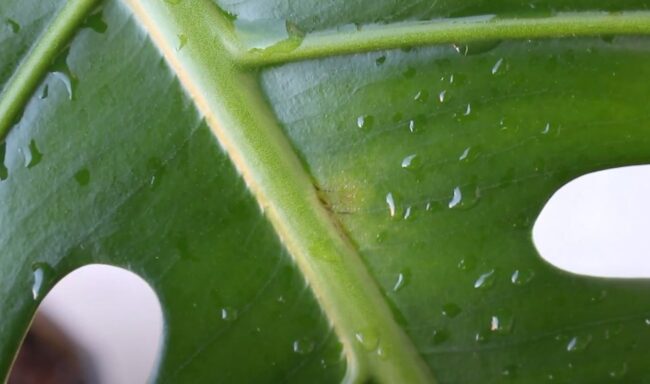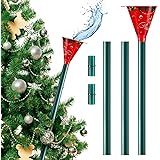If you’re noticing tiny, annoying pests on your beloved monstera plant, fear not! We’ve got you covered on how to treat thrips on monstera. These pesky insects can quickly multiply and wreak havoc on your plant, causing damage to its leaves and hindering its growth.
But fret not, because we have some effective and practical solutions to help you restore your monstera’s health and beauty. So, let’s dive in and discover how you can rid your monstera of these troublesome critters, allowing it to thrive once more.
How to Treat Thrips on Monstera: A Comprehensive Guide
Thrips can be a real nightmare for monstera plant owners, as these tiny insects can quickly infest and damage your precious foliage. If you’ve noticed small, slender bugs on your monstera leaves or the tell-tale signs of damage such as silver streaks, white patches, or distorted growth, it’s likely that thrips have made themselves at home.
Understanding Thrips and their Impact on Monstera Plants
Before diving into treatment options, let’s understand the culprits behind the damage: thrips. Thrips are tiny insects, usually less than 1/20 of an inch in length, that belong to the order Thysanoptera. These pests feed on plant cells by sucking the sap, causing injury to the foliage. They are typically attracted to the new growth on monstera plants, making younger leaves more susceptible to infestation.
Thrips damage on monstera leaves manifests as silver streaks, white patches, browning, or curled edges. These signs can compromise the overall aesthetic appeal of your monstera and, if left untreated, can weaken the plant and impact its overall health. Therefore, it is crucial to take prompt action to eliminate thrips and protect your monstera from further harm.
Step 1: Identify and Isolate Infested Plants
The first step in treating thrips on your monstera is to identify the infested plants and isolate them to prevent the pests’ spread. Inspect your monstera plant carefully, focusing on the undersides of leaves, where thrips tend to hide. Look out for the presence of thrips, which may appear as tiny, elongated bugs ranging in color from pale yellow to black.
Once you’ve identified the infested plants, move them away from other houseplants to avoid thrips infesting nearby plants. This isolation step is vital because it helps contain the infestation and prevents the thrips from easily spreading throughout your indoor garden.
Step 2: Remove Affected Leaves
To prevent further damage and inhibit thrips from reproducing, it’s important to remove any visibly affected leaves. Thrips larvae often hide in the curled or distorted parts of the leaves, so carefully inspect each leaf and prune those that show signs of heavy infestation. Use sterilized pruning shears or scissors to make clean cuts near the base of the affected leaf.
After removing the damaged leaves, discard them in a sealed plastic bag or dispose of them far away from your other plants. Thoroughly clean the pruning tools with rubbing alcohol or a bleach solution before using them on other plants to avoid spreading thrips or other potential pests.
Step 3: Wash the Monstera Plant
To get rid of any remaining thrips or their eggs on the monstera plant, washing the leaves is an effective and non-toxic approach. Follow these steps to properly wash your monstera plant:
- Take your monstera to the sink or bathtub, ensuring that the water won’t damage the surrounding area.
- Gently hose down the leaves with a gentle spray of lukewarm water, making sure to reach both the upper and lower surfaces.
- For a more thorough cleanse, add a few drops of mild liquid dish soap or insecticidal soap to a spray bottle filled with water.
- Spray the soapy solution onto the leaves, focusing on the affected areas and undersides of the leaves.
- After a few minutes, rinse off the soap with lukewarm water, ensuring all residue is removed.
- Allow the monstera plant to drain and dry before returning it to its usual location.
This gentle washing process helps dislodge any remaining thrips and removes their eggs from the monstera, reducing the likelihood of reinfestation.
Step 4: Apply Organic Thrips Control Methods
After the initial cleaning, it’s time to bring out the big guns – organic thrips control methods. These methods are effective in managing thrips populations and minimizing their impact on your monstera plant. Here are a few natural remedies you can try:
Neem Oil
Neem oil is a popular organic insecticide that disrupts the feeding and reproductive systems of thrips, ultimately killing them. Follow these steps to treat your monstera with neem oil:
- Mix neem oil with water according to the package instructions.
- Transfer the diluted neem oil into a spray bottle.
- Spray the neem oil solution onto the entire monstera plant, focusing on areas where thrips are prevalent.
- Repeat this process every five to seven days for several weeks or until the thrips infestation is under control.
Beneficial Insects
Introducing beneficial insects such as predatory mites or lacewings can help keep thrips populations in check. These natural predators feed on thrips and serve as a long-term solution for pest control. You can purchase these insects from specialized online stores or garden centers. Follow the instructions provided with the beneficial insects on how to introduce and maintain them in your monstera garden.
Step 5: Monitor and Maintain
Once you’ve implemented the treatment methods mentioned above, it’s crucial to monitor your monstera plant regularly for any signs of recurring thrips infestation.
Thoroughly inspect the leaves, especially the new growth, and keep an eye out for any silver streaks, white patches, or distorted leaves. If you notice any resurgence of thrips, repeat the treatment process promptly.
Additionally, maintaining a healthy and thriving monstera plant can significantly reduce the chances of future thrips infestations. Ensure your monstera is provided with proper care, including adequate sunlight, appropriate watering, and a well-balanced fertilizer regimen. A healthy monstera is more resilient to pests and can better withstand potential infestations.
Remember, prevention is always better than cure when it comes to thrips on your monstera. Regularly inspect your plants, implement good gardening practices, and promptly address any signs of thrips to keep your monstera plants vibrant and pest-free.
So, armed with this comprehensive guide, go ahead and tackle those thrips on your monstera plants. Your leafy greens will thank you for it!
Frequently Asked Questions (FAQs)
To treat thrips on your Monstera plant, follow these steps:
The signs of a thrip infestation on a Monstera plant include:
Yes, you can use natural remedies to get rid of thrips on your Monstera plant. Some effective natural solutions include:
Yes, it is recommended to isolate your Monstera plant if it has thrips. This will help prevent the infestation from spreading to other plants.
It is important to regularly check your Monstera plant for thrips, especially if you have had previous infestations. Check the undersides of the leaves and inspect for any signs of thrips.
Yes, insecticides can be used to treat thrips on your Monstera plant. However, it is important to choose an appropriate insecticide that is safe for indoor plants and follow the instructions carefully.
The time it takes to get rid of thrips on a Monstera plant can vary depending on the severity of the infestation and the treatment methods used. It is important to be consistent with the chosen treatment and continue monitoring the plant for any signs of thrips.
Yes, thrips can easily spread to other plants in your home. It is important to take immediate action and isolate any infected plants to prevent the infestation from spreading.
Final Thoughts
Thrips are a common pest that can wreak havoc on your monstera plant. To effectively treat thrips on monstera, there are a few key steps you can take. Firstly, inspect your plant regularly to detect any signs of thrips infestation. If you spot thrips, start by isolating the affected plant to prevent the pests from spreading. Next, carefully remove any heavily infested leaves and discard them. You can also use organic insecticidal soap or neem oil to treat thrips on monstera.
Apply the solution to the leaves, ensuring complete coverage. Repeat the treatment every few days until the thrips are gone. Remember to also maintain a clean and sanitary environment for your plant by removing any debris or fallen leaves. By following these steps, you can effectively treat thrips on your monstera plant and ensure its health and vitality.
Auto Amazon Links: No products found.
Perfect Plants Christmas Tree Saver 8oz. | Easy Use Xmas Tree Preserver Food | Have Healthy Green Christmas Trees All Holiday Season
$9.97 (as of December 16, 2025 05:22 GMT +00:00 - More info- Product prices and availability are accurate as of the date/time indicated and are subject to change. Any price and availability information displayed on [relevant Amazon Site(s), as applicable] at the time of purchase will apply to the purchase of this product.
FirEver Pure Christmas Tree Food | Preserver Additive & Season Extender for Live Xmas Trees | Keep It Green, Reduce Needle-Drop | Miracle Freshness (8 oz)
$14.99 (as of December 16, 2025 05:22 GMT +00:00 - More info- Product prices and availability are accurate as of the date/time indicated and are subject to change. Any price and availability information displayed on [relevant Amazon Site(s), as applicable] at the time of purchase will apply to the purchase of this product.
Rocky Mountain Goods Christmas Tree Food - 8 oz Tree Preservative - Reduce Needle Drop - Greener Scent - Fir, Pine, Spruce Trees - Extend Tree Life
$9.95 (as of December 16, 2025 05:22 GMT +00:00 - More info- Product prices and availability are accurate as of the date/time indicated and are subject to change. Any price and availability information displayed on [relevant Amazon Site(s), as applicable] at the time of purchase will apply to the purchase of this product.
EZMeetU Christmas Tree Watering Funnel, 47 Inch Flower Shape Adjustable 6 Section Design, Christmas Tree Watering System, Christmas Tree Waterer, Long Funnel Wide Opening Reusable, Plant Watering Tool
$16.99 (as of December 16, 2025 05:22 GMT +00:00 - More info- Product prices and availability are accurate as of the date/time indicated and are subject to change. Any price and availability information displayed on [relevant Amazon Site(s), as applicable] at the time of purchase will apply to the purchase of this product.
VICAMB 39.3 Inch Christmas Tree Watering Funnel,Christmas Tree Watering System Device,Long Tree Watering Funnel Spout for Indoor Outdoor Xmas Tree
$17.99 (as of December 16, 2025 05:22 GMT +00:00 - More info- Product prices and availability are accurate as of the date/time indicated and are subject to change. Any price and availability information displayed on [relevant Amazon Site(s), as applicable] at the time of purchase will apply to the purchase of this product.
Snow Joe Premium Enviro Blend Ice Melt, Green-Coated Deicer Crystals, 50 lb - Safer Melter for Vegetation, Concrete & Metals w/ Anti-Corrosion Calcium Magnesium Acetate
$32.97 (as of December 12, 2025 19:27 GMT +00:00 - More info- Product prices and availability are accurate as of the date/time indicated and are subject to change. Any price and availability information displayed on [relevant Amazon Site(s), as applicable] at the time of purchase will apply to the purchase of this product.
Muddy Mat® Shown on TV Super Absorbent Microfiber Dog Door Mat for Muddy Paws, Non-Slip Washable Pet Rug, Quick Dry Chenille Entryway Carpet, Machine Washable Indoor Outdoor mat, Grey 30"x19"
$24.95 (as of December 12, 2025 19:27 GMT +00:00 - More info- Product prices and availability are accurate as of the date/time indicated and are subject to change. Any price and availability information displayed on [relevant Amazon Site(s), as applicable] at the time of purchase will apply to the purchase of this product.
ivtivfu Rolling Grill Basket, Removable Wooden Handle, 304 Stainless Steel, Nesting BBQ Tools, Smoker Grilling Accessories for Vegetable, Outdoor Cooking Camping, Birthday Gifts for Men Dad Husband
$25.99 (as of December 12, 2025 19:27 GMT +00:00 - More info- Product prices and availability are accurate as of the date/time indicated and are subject to change. Any price and availability information displayed on [relevant Amazon Site(s), as applicable] at the time of purchase will apply to the purchase of this product.
XXXFLOWER Plant Terrarium with Wooden Stand, Air Planter Bulb Glass Vase Metal Swivel Holder Retro Tabletop for Hydroponics Home Garden Office Decoration - 3 Bulb Vase
$18.98 (as of December 12, 2025 19:27 GMT +00:00 - More info- Product prices and availability are accurate as of the date/time indicated and are subject to change. Any price and availability information displayed on [relevant Amazon Site(s), as applicable] at the time of purchase will apply to the purchase of this product.
Zevo Flying Insect Trap Official Refill Cartridges - Fits Both Zevo Trap & MAX Indoor Fly Trap - Authentic Trap+Lock Technology to Catch Gnats, House & Fruit Flys (4 Official Refill Cartridges)
$14.97 (as of December 12, 2025 19:27 GMT +00:00 - More info- Product prices and availability are accurate as of the date/time indicated and are subject to change. Any price and availability information displayed on [relevant Amazon Site(s), as applicable] at the time of purchase will apply to the purchase of this product.











